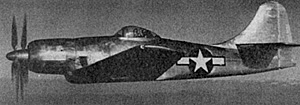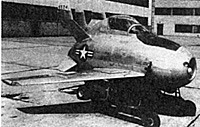 While it's not really a Gamers' product (couldn't be, I'm giving it away for free...), I want to explain a little about my Air Combat Maneuvering game (ACM)--a game I enjoy more than anything else I've ever produced.
While it's not really a Gamers' product (couldn't be, I'm giving it away for free...), I want to explain a little about my Air Combat Maneuvering game (ACM)--a game I enjoy more than anything else I've ever produced.
At right, Boeing XF8B-1 prototype built toward the end of WWII as a fast, long-ranged shipboard aircraft. It uses a 3000HP radial engine driving two counter-rotating six-blade propellers.
It Came Out of the Blue
This all began several years ago when I decided to combine a love of aircraft (I had just started working on my Private Certificate), along with an attempt to find a gaming outlet that wasn't directly related to work (something just for fun). Seeing what was out there, I chose what I thought was the best available air game (JD Webster's work available form Clash of Arms) and mated it to a miniatures format. This gave me an outlet for a number of smaller tasks that are good diversions from everyday issues: painting, mechanical design, and so on. I chose to go off of an existing system because I did not want to design a game (I just wanted to adapt it to miniatures)--keep in mind that game design is what I do for work.
It did not take long before I started tinkering with the boardgame's rules (OK, I couldn't keep my hands out of the pie). From the beginning, I had (and have) no intention of making this a production game for the company. So I decided that no harm would be done if I added the flight model detail I wanted, with the sky the limit for complexity, as I did not need to concern myself with what anybody else could handle. The resultant mutant, accurate in its physics, turned into an unplayable log-filling exercise. Not much fun.
Sometime in early 1997, I started toying with the idea of converting the manual flight logs (and their host of supporting equations then converted into game tables) into a computer spreadsheet. My reasoning was that the computer could then use the formulas directly from raw aircraft data to compute the assorted game functions. That would allow extensive numbers of aircraft to be modeled, the workload to be light, and the game to be devoid of table-breaks. Luckily, I didn't know how difficult the task I assigned myself was going to be.
Now, over a year later, the program has been tweaked, massaged, debugged, and automated to the point where the version changes have gotten under control (at v9t) and the program semi-stable. I've made every effort to address any bugs or anomalous results as they have shown themselves during hundreds of turns of play. The computer format allows me to fix them right away and issue a new version via the web site (it is a good idea to check every once in a while to see what version is current and to download the latest if you don't have it).
Dang Near Rocket Science
I'm very happy with the results. From some aircraft data and four player control inputs, the program automatically works through dozens of aerodynamic formulas, abundant control checks, and more table cells than I'd like to think about to instantly spit out the player's aircraft's gameturn movement on the hex grid, in altitude, pitch, bank, and airspeed. It adjusts all these parameters as flight continues. It checks for and applies the effects of stalls, incipient and autorotational spins, torque, critical Mach and the development of air pressure through that speed and into supersonic flight, gyroscopic precession, parasitic and induced drag, hydraulic controls, stick force due to dynamic air pressure, pilot effects from red out to GLOC...to include recovery from them and the body's adaptation to G-Loads, the effect of wing sweep on Mach effects, and much more.
The model is valid out to Mach 3 (it cannot go faster than that due to a lack of a speed-temperature model) and the only major flight realm it does not model is take-off and landing (it doesn't understand that the ground can support the weight of the aircraft...). While I may someday decide to put in the ability to take off and land, I think I'll leave above Mach 3 speeds to somebody else. A complete listing of the assumptions and known limitations of the model are described in Column E in the model's program file.
The Shot Calculator, combined with firing modifiers from the aircraft files and two on-map measures, gives such things as tracking shots, slant range, target aspect, firer cone, minimum range, effects of: aircraft damage, pilot G-effects, gyroscopic gunsights, aircraft G-Loads, and so on. Again, for the price of inputting two numbers and some basic aircraft data, players effortlessly work through a host of equations to generate the shot data they need.
The amount of detail available to the player in the model and the complete lack of player work load to make it happen allows the player to concentrate on fighting his plane against the bad guys--which is what it is all about anyway, right?
One of my main goals in designing this game was to set it up to play gladiatorial-like contests between a whole range of aircraft types--so as to evaluate them (to my satisfaction) against each other. Some take issue with this emphasis and point to various statistics to show that most kills were blind-side bounces and so on. I'm happy for them, but I did not design all this just to show that when an aircraft is surprised by a bad guy on his six, his chances are slim. Rather, I wanted to explore the tactics of ACM--scissors, lag rolls, lag pursuits, brackets, nose-to-nose vs nose-to-tail maneuvers, energy vs angles maneuvering, how to handle multiple aircraft (friendly and enemy), as well as dealing with dissimilar aircraft characteristics.
In short, I wanted to play the dogfight, not show how I got (or didn't get) there. If somebody is looking for an operational air game, this isn't it. If they are looking for an accurate flight model to duel it out between 3-D miniatures on a table, this is it.
Combat Aircraft--Collect 'em All!
That being the case, I endeavored to include as many aircraft types on which I could find the needed data. I was able to add all sorts of experimental and prototype aircraft that many have never heard of...and fewer still have ever been able to play with. Yes, all the standards are here (Mustang, Zero, Focke Wulf, etc.), but so too are the really weird ones. Two examples will suffice: the Goblin and the Me-163b/U1.
 The Goblin is the little parasite fighter designed to fit inside the belly of a B-36 bomber (also included). Once launched, its goal was to shoot down the threat facing the bomber and then "land" inside the bomber again for the ride home. Cute idea.
The Goblin is the little parasite fighter designed to fit inside the belly of a B-36 bomber (also included). Once launched, its goal was to shoot down the threat facing the bomber and then "land" inside the bomber again for the ride home. Cute idea.
At right, the Goblin sits atop a trolley to make up for a lack of landing gear--it was designed to be launched and recovered by a B-36 bomber using a hook arrangement extending along its nose (retracted in photo).
Two prototypes were built--one crashed during testing, the other is displayed at the Wright-Patterson Air Force Museum. Naturally, I had to have this in the game and I can safely say (from the comfort of my chair) that I've flown and died in it. Unfortunately, I got into a compressibility dive in it and could not pull out before hitting the ground. The Me-163b/U1 is a variant including ten 50mm free-flight rockets which are launched via a photoelectric cell. The rockets are designed to pepper a B-17 as the Komet passes underneath. No one has yet actually flown this model, although at a recent gathering we allowed the guy in the Komet (Chris Volny) to execute such a shot just to see what would happen. Had he been in this model, he would have gotten a kill. (That would match the war record of this variant, as the Germans were able to record one kill on a B-17 using this system during tests.)
In addition to being able to "test fly" some of the more bizarre contraptions built over the last nearly 100 years, players can also team up unlikely pairings to test the against each other. Pitting some of the "drawing-board only" Nazi wonder-weapons against post-war Allied jets is rather interesting, as is pitting early or pre-war aircraft against their late-war counterparts. What a difference a few war-years makes!
The model is versatile enough to handle any fight from WW1 through modern where the current laws of physics and aerodynamics apply (don't try to fly a UFO using the model). WW1 fights require a smaller ground scale and are, I think, a load of fun. Be careful though, the gyroscopic effects of a rotary engine (Camels, as well as many German and French aircraft) can come back to bite the player. It is best to fly about some with a rotary engine by yourself seeing how it behaves before taking on other players (this will save you some embarrassment).
More modern aircraft will be added shortly (geez, the French have a lot of types...). The system does not as yet have an air-to-air missile resolution system and I hope to get one on-line sometime in the next year. I've been saying that to myself for some time now. Originally, I wanted the machine to "fly" the missile for the player, but I believe that to be a programming task beyond my limited experience. Now, I'm not quite sure how I want to handle it.
A couple of players of ACM have suggested that they could develop a stand-alone application for this game which would simplify and speed play even more. As of this date, they have not been able to direct serious attention to getting it done. Should they do so, it would be available from us on diskette for a small fee.
Getting in on the fun...
To be played in its entirety, the game requires a computer with either Excel or MS Works and aircraft miniatures (with appropriate stands and so on), the program files, and the "Lessons" (both available at the web site, see page 4 for the URL). Fear not, if you'd rather use cardboard counters and hex maps, you can--the difference is a loss of some visual cues. We have been playing w/o miniatures in a PBEM game that has been running for months and it works quite well--not the same as face-to-face, but a heck of a lot more fun than not playing! See you in the skies!
Back to Table of Contents -- Operations #30
Back to Operations List of Issues
Back to MagWeb Master List of Magazines
© Copyright 1998 by The Gamers.
This article appears in MagWeb (Magazine Web) on the Internet World Wide Web.
Other military history articles and gaming articles are available at http://www.magweb.com